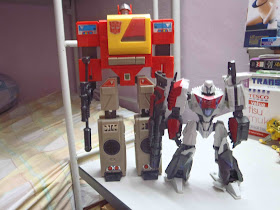Intro:
One of the most memorable/ significant rivalries during the G1 era, apart from that of Optimus – Megatron, Galvatron – Rodimus Prime, Ultra Magnus – Cyclonus, and of course, who can forget Soundwave – Blaster.
Blaster is the Autobots’ answer to Soundwave. Soundwave has his own minions of cassette bots, and the Autobots have to have someone with the same capability, alas Blaster was created. Blaster was one of those Transformers where the concept of mass displacement was heavily used. Based on various depictions, Blaster’s robot mode is at least that of normal Transformers, but when transformed, he shrinks to a normal boom box size, able to be fitted into a car as small as Bumblebee or even be carried around by a human. As with Soundwave, he too leads a number of cassette-bots, with Ramhorn, Steeljaw, Rewind and Eject being heavily showcased in various Transformers-related media, namely the comics and the G1 animated series. Another two characters lesser known cassette-bots are Grandslam and Raindance, who can merge together and form Slamdance.
I always wanted a Blaster figure, and when Hasbro decided to release the SDCC-exclusive Blaster figure via its Universe line, I knew that this was my best ever chance to own him.
So without further ado, let’s go straight to the review.
Alternate Mode:
Unless you’ve been living under a rock somewhere and been marooned in outer space since prior to 1984, Blaster transforms into a classic radio cassette deck boom box, albeit a strangely-colored one. He is predominantly red and yellow in color. His red is not really deep-red or bright-red, but rather soft-red, if you get the meaning.
Most of the radio buttons do not really function, except the eject-button, which is the button nearest to his right hand. His size isn’t really life-sized, but is rather small than your regular boom box, but definitely bigger than your normal G1-era Transformers.
I can’t really compare it to the original figure, but the cassette compartment in this version can only be fitted with one cassette and not more. So although there are three other cassette-bots that comes along with this set (to be reviewed below), only one can be fitted in at any given time. Also, one thing that most of the original G1 figures lack is the ability to store their accessories, and in this case, the guns and also the cassette-bot’s weaponries.
 |
| Size Comparison |
Robot Mode:
In his robot mode, he’s huge and tall, but quite light as there are no die-cast parts whatsoever. The robot mode is blocky at best, with very, and I do mean very minimal articulations. The head is able to lift up and rotate 360°, mostly due to its transformation. The arms rotate at the shoulders and the legs can swing out sideward awkwardly, and again, even that is due to its transformation. Then finally, Blaster comes with wrists articulation as well, and that’s about it.
It is quite unfortunate that Soundwave and Blaster, as much as they are eternal rivals as far as fiction goes, the action figures themselves differ vastly in terms of size, with Soundwave being too diminutive to the Blaster’s goliath size.
 |
| Robot size comparison |
Cassette-bots:
 |
| From Left: Ramhorn, Eject & Steeljaw |
Firstly, do I really need to tell you what alternate mode that these guys posses? Seriously? Anyways, the alternate mode looks convincing enough, but you can only find the decals on one side. Eject’s cassette mode is probably the most convincing of all. And the best part is that the set also comes with a cassette casing, which is a really neat idea. And as I have said earlier with the Blaster figure itself, there is nowhere to store the cassette-bots excess accessories either.
 |
| Cassettes Front View: (from left) Eject, Steeljaw & Ramhorn |
 | |
|
Ramhorn:
Ramhorn transforms into a miniature rhino – albeit a heavily-armed one. Since he is a G1-era cassette-bot, you obviously should not expect more from its articulation, hence there are no rotation joints, only swivels. The hips, elbows, knee, feet, head and tail all swivel. In fact, he has even more articulation joints that Blaster himself!!!
Steeljaw:
Steeljaw transforms into a yellow-colored tiger and is probably one of the most well-known Autobots cassette-bots. Articulation-wise, he is exactly as Ramhorn. I actually prefer him among the three cassette-bots. As with Ramhorn, Steeljaw is equally heavily-armed, with guns mounted on both sides of his body.
Eject:
Eject is the only humanoid among the three cassette bot that came with this set, and is basically blue in color. Articulation-wise, he fared way better that Blaster. The shoulders and elbows both rotate. The legs swing backward at the hips and there is also knee articulation!!!
In robot mode, Eject wields a pair of huge guns.
Overall:
First of all, I have to say, Blaster is one of G1-era more famous characters. He played quite a roll in the animated series, and an even more significant role in the comics. However, as far as the figure goes, I can’t say that I really dig it. Personally, I think the Blaster figure itself is a bit dull, and having very limited articulations made it worse. The only saving grace for this set, at least for me it is, the cassette-bots themselves – they do add quite a play value to the set.
Final verdict: 6/10 (Blaster figure), 8/10 (Set)








No comments:
Post a Comment